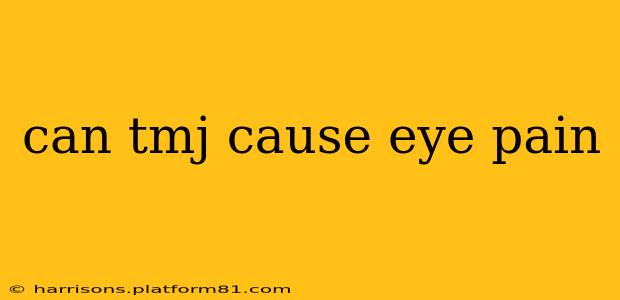Temporomandibular joint (TMJ) disorders affect the jaw joint and the muscles controlling chewing. While the jaw is far removed from the eyes, many sufferers report experiencing eye pain alongside their TMJ symptoms. This connection, while not always straightforward, is increasingly recognized by medical professionals. This article explores the potential link between TMJ and eye pain, answering common questions and providing insights into diagnosis and treatment.
How Can TMJ Possibly Affect My Eyes?
The link between TMJ and eye pain isn't a direct one involving physical damage to the eye itself. Instead, the connection is thought to stem from several interconnected factors:
-
Referred Pain: This is the most commonly cited explanation. Referred pain occurs when pain originating in one area of the body is felt in another. The trigeminal nerve, a major nerve responsible for sensation in the face, including the jaw and eye areas, plays a crucial role. Irritation or dysfunction in the TMJ can trigger signals along this nerve, resulting in perceived pain in the eye or surrounding areas, even though the eye itself isn't the source of the problem.
-
Muscle Tension: TMJ disorders often involve significant muscle tension in the jaw, face, and neck. This tension can spread, impacting the muscles around the eyes and causing headaches, eye strain, and even eye pain. The constant clenching or grinding of teeth associated with TMJ can exacerbate this muscle tension.
-
Postural Issues: Poor posture, often linked to TMJ, can strain the neck and upper back muscles. This strain can, in turn, affect the muscles surrounding the eyes, contributing to eye pain and discomfort.
-
Sinus Issues: While not always directly connected, TMJ dysfunction can sometimes exacerbate sinus problems, leading to pain around the eyes and temples. This is because the sinuses are close to the jaw and facial muscles affected by TMJ.
What are the Symptoms of TMJ-Related Eye Pain?
Eye pain associated with TMJ is often described as:
- A dull ache or pressure: This is often felt around the eye, rather than directly in the eye itself.
- Sharp, stabbing pain: This type of pain may be less common but can occur in some individuals.
- Eye strain or fatigue: This is often associated with prolonged muscle tension around the eyes.
- Headaches: Headaches, especially tension headaches, are frequently reported alongside TMJ and eye pain.
- Sensitivity to light (photophobia): This symptom is less common but can occur due to the overall tension and discomfort.
Can TMJ Cause Double Vision?
While less common than other forms of eye pain, some individuals with TMJ have reported experiencing temporary double vision or diplopia. This is usually linked to the muscle strain and tension affecting the eye muscles themselves or due to the overall stress and tension in the head and neck. However, double vision can be a symptom of various neurological conditions, and it's crucial to seek professional medical assessment to rule out other potential causes.
How is TMJ-Related Eye Pain Diagnosed?
Diagnosing TMJ-related eye pain requires a thorough examination by a healthcare professional, often a dentist specializing in TMJ disorders or an ophthalmologist. They will:
- Assess your TMJ: This will involve checking your jaw range of motion, listening for clicking or popping sounds, and examining your jaw muscles for tenderness.
- Evaluate your eye symptoms: This involves a comprehensive eye exam to rule out other causes of eye pain.
- Review your medical history: Understanding your past medical issues and other symptoms is vital.
- Possibly order imaging tests: X-rays or other imaging studies might be necessary to rule out other conditions.
How is TMJ-Related Eye Pain Treated?
Treatment for TMJ-related eye pain usually focuses on managing the underlying TMJ disorder. Options may include:
- Pain relievers: Over-the-counter pain relievers like ibuprofen or naproxen can help alleviate pain and inflammation.
- Muscle relaxants: Prescribed muscle relaxants can help reduce muscle tension.
- Physical therapy: Targeted exercises and stretches can help improve jaw mobility and reduce muscle tension.
- Splints or mouthguards: These devices can help prevent teeth grinding and reduce jaw strain.
- Injections: Corticosteroid injections might be used to reduce inflammation in severe cases.
- Surgery: Surgery is a rare but last resort for severe cases that don't respond to other treatments.
It's essential to consult with a qualified healthcare professional if you are experiencing eye pain and suspect a link to TMJ. They can provide an accurate diagnosis and recommend appropriate treatment options. Remember that this information is for educational purposes only and should not be considered medical advice.
